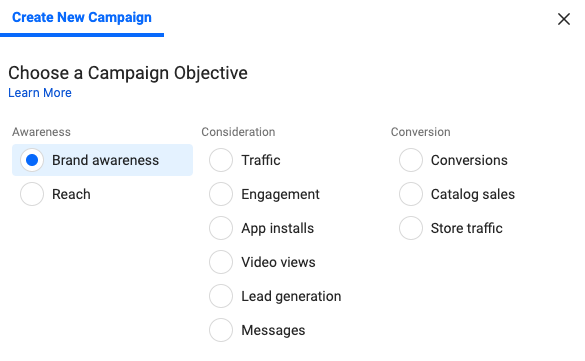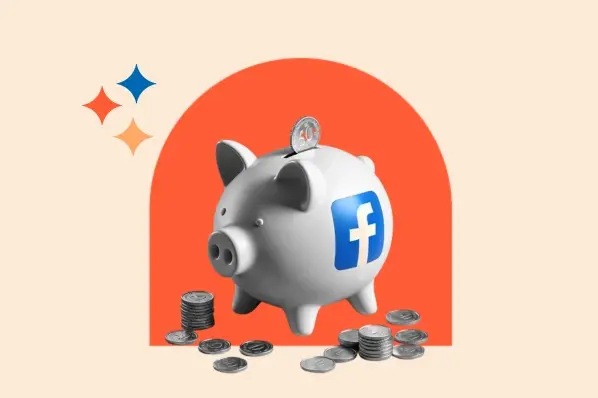Within Facebook Ads Manager, there are 11 objectives spanning the three overarching categories of the buyer’s journey: awareness, consideration, and conversions.

With so many options, the thought of determining which objective is best for you may feel a bit overwhelming, but no sweat — we’ll break them down below.
Check out HubSpot's free course on Facebook Ads Training: How to Build Great Ads & Audiences
Awareness Facebook Campaign Objectives
Awareness objectives help generate interest in your product or service.
1. Brand Awareness
As you may have guessed, these ads help increase people’s awareness of your business. If you’re looking to introduce your brand to new audiences, this can be a great option. That's because Facebook will show these ads to members of your target audience who are more likely to pay attention to and recall the ads.
Facebook predicts recall ability by polling users on whether they remember seeing an ad and analyzing their past behavior and interactions with ads.
Keep in mind the sole focus of these ads is to make people aware of your brand, so you shouldn’t expect significant engagement or click-throughs. However, they will help you establish brand familiarity and pique the interest of your target audience.
Use these ads to keep consumers aware of, and able to recall, your brand as well as highlight what makes your business and product/service unique.
TLDR: Choose this ad to increase the chances of your target audience recognizing and recalling your brand, and the features that make it stand out from competitors.
2. Reach
Facebook reach ads are shown to as many people in your target audience as possible while staying within your budget constraints. You can even specify the specific location you would like your audience to be in, so the ad only reaches people near your business. An added bonus is the ability to choose the frequency of these ads, meaning how many times someone will see the ad.
On one hand, this strategy maximizes the number of people who see your ad. On the other, Facebook doesn’t take into consideration the likelihood of the user paying attention to the ad. Meaning, you may end up paying for your ad to be displayed to audience members who tend to scroll past any form of advertisement on the platform.
TLDR: Choose this ad to send your business message to as many of your target audience members as possible, even if it means attempting to reach those who typically ignore ads. This objective can work well for local businesses.
Consideration Facebook Campaign Objectives
Consideration objectives encourage audiences to think and learn more about your business.
3. Traffic
The traffic objective aims to send people from Facebook to any URL of your choosing, such as your website’s homepage, online storefront, app, event page, etc.
Facebook does this by showing your ads to users who are likely to click based on their past behavior on the platform (newsflash: Facebook knows a lot about its users). By bringing more visitors to your featured destination, you’ll increase the likelihood of a user taking favorable actions on your landing page.
Note that, with the traffic objective, Facebook is only responsible for collecting clicks and does not measure any action(s) — or lack thereof — a user takes once they leave the platform.
TLDR: Choose this ad to direct viewers to a new URL destination so they can learn more about what you’re offering or promoting.
4. Engagement
Also based on past behavior, the platform shows engagement ads to those who they predict will engage with your ads in the form of likes, reactions, comments, and shares. The are 3 types of engagement ads: post engagement, page likes, and event responses.
Post engagement and page likes will boost engagement for your ad and Facebook business page respectively. Event response engagement ads are a unique way to promote your event to increase attendance and get people excited.
Engagement ads use social proof to determine where users are more likely to pay attention to, and be interested in, an ad after seeing how others interact with it.
Take yourself for example — would you spend more time considering an ad with 473 likes or an ad with 14 likes? I’ll take the former, please.
When others engage with your ads, their activity will also be shared with their Facebook friends, reaching even more people. Their validation will help your online word-of-mouth marketing.
TLDR: Choose this ad to establish brand credibility through likes, comments, and shares and increase interaction with your business on Facebook.
5. App Installs
This objective helps drive mobile app installs by taking users directly to the App Store or Google Play store to download your app. Facebook shows these ads to members of your target audience who have previously downloaded apps from ads to increase chances of your app installations.
TLDR: Choose app installs ads to increase app downloads for your business.
6. Video Views
Facebook will push video views ads to your target audience with the objective of getting as many views as possible. These ads can be a powerful way to tell your brand story or show your service in an engaging and consumable. After all, a HubSpot report found that over 50% of consumers want to see video content from brands.
What’s really valuable about video view ads is their ability to help you retarget those who watched your video. You can retarget people who watched your video content to remind them of your brand and product/service in hopes of boosting brand awareness and conversions.
TLDR: Choose this ad to use video to share information about your business and reach your audience via an engaging medium. Then, retarget your viewers to boost chances of conversion.
7. Lead Generation
Lead generation ads are a great way to embed lead magnets and collect leads while allowing the user to stay on Facebook. Users submit their personal information in exchange for an offer created by your business, such as an email newsletter or workbook.
The ability for the user to remain on Facebook is a huge advantage for this type of ad. This makes it easy for the user to fill in the ad’s form, while never leaving the page or straying too far from what it is they originally went to the platform for — this results in a seamless UX and can increase chances of conversion.
Facebook can even auto-fill these forms by pulling contact information from the user’s account details so all they have to do is click "Submit”.
TLDR: Choose this ad to collect leads for your business with an enticing offer. This works best when the user is already in the consideration stage of their buyer’s journey and is therefore willing to exchange their information for something of value in return.
8. Messages
With the messages objective, viewers can directly message your business through the ad using Facebook Messenger.
This is an effective way to personally connect with users to generate more interest in your business. Engaging with your audience through Messenger allows you to connect with your audience versus talking at them.
Leverage your conversations as an opportunity to answer any questions, offer customer support, build rapport with your audience, collect leads, and drive sales. Messenger is a great way to show your customers that there’s a human on the other end, ready to help them.
With these ads, it’s crucial that you’re ready to respond quickly and effectively once the messages flow in. Otherwise, prospective customers may lose interest if you’re not responsive to their inquiries.
TLDR: Choose this ad to encourage users to contact your business through Facebook Messenger, if you’re prepared to respond in a timely manner.
Conversion Facebook Campaign Objectives
Conversion objectives nudge audiences to buy or use your product or service.
9. Conversions
The goal of conversion ads is to encourage people to take valuable actions on your website or app, such as registering for an event, adding an item to cart, or making a purchase.
These ads are most successful when delivered to people who are already familiar with your product — likely, those who have gone through the awareness and consideration stages and need an extra push toward conversion.
Installing the Facebook pixel on your website will be required for these ads to help Facebook optimize your campaigns. The pixel is a piece of code for your site that tracks each time a user takes action and converts through a Facebook ad. With each conversion, Facebook learns who to target in the ads to maximize conversions.
TLDR: Choose this ad to increase conversion actions on your site or app. These ads should be served to those who are already knowledgeable about your business.
10. Catalog Sales
The catalog sales ad is made with a holistic view of ecommerce stores in mind. Instead of promoting a single product or service, ads with this objective will show relevant products from your store to people who have demonstrated interest in them before. Facebook is able to recognize this behavior based on its understanding of your offerings and the user through its pixel.
These ads require you to integrate your product catalog with Facebook so the platform can pull a selection from your store and adjust it as needed for audience members based on various factors, such as your latest arrivals.
Catalog sales ads are also more specific than conversion ads because the end goal is to generate sales, whereas the goal of conversions ads can vary from increasing registration or adding payment information.
TLDR: Choose this ad if you prefer Facebook select which products from your catalog are most relevant for your audience, based on their machine learning predictions, in order to increase sales.
11. Store Traffic
The store traffic objective is perfect for businesses with physical locations as the goal is to remove the digital barrier and bring in-person foot traffic to your store.
The ads are delivered to people who are physically near your store, so they are more likely to visit. It’s important to mention these ads target based on location only, which means audience demographics will not be considered.
There are two necessities for store traffic ads to work. As the advertiser, you must ensure that all your business locations are properly entered in Business Manager. For the consumer, their location services must be enabled so Facebook knows when to show the ad.
With those stars aligned, you’ll be able to track your store visits at each location from the ad.
TLDR: Choose this ad if your business has brick and mortar locations and you’re looking to increase store visits.
Now, when you log into Facebook Ads Manager, you should have a better idea what all the campaign objectives mean. If you’re ready to roll your sleeves up, we can help you step-by-step through the Facebook ad creation process.
.png?width=112&height=112&name=Image%20Hackathon%20%E2%80%93%20Vertical%20(75).png)




![Anatomy of a Facebook Ad: How to Create Scroll-Stopping Campaigns [+ Examples]](https://53.fs1.hubspotusercontent-na1.net/hubfs/53/anatomy-of-a-fb-ad.png)



.jpg)
![What Is Facebook CBO? Budget Optimization Done Right [Tutorial]](https://53.fs1.hubspotusercontent-na1.net/hubfs/53/facebook-cbo.jpg)
